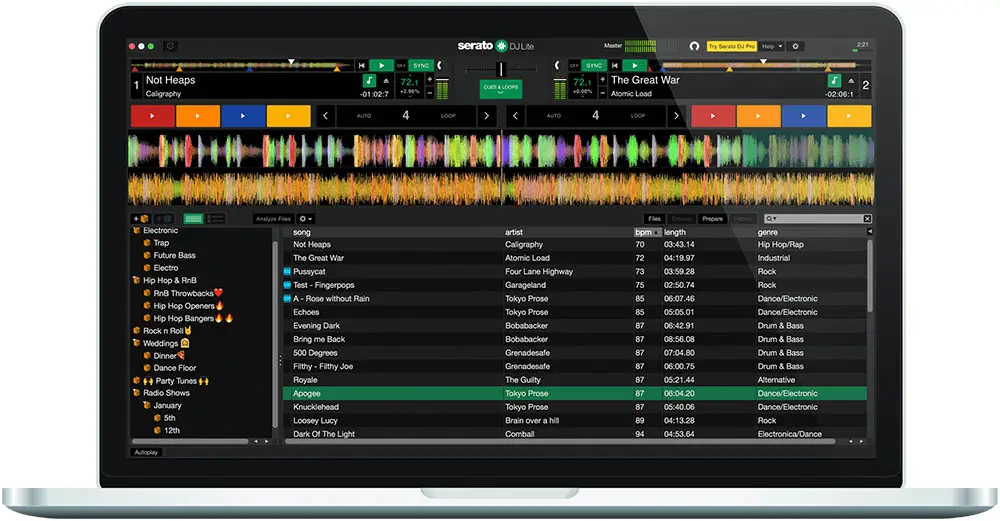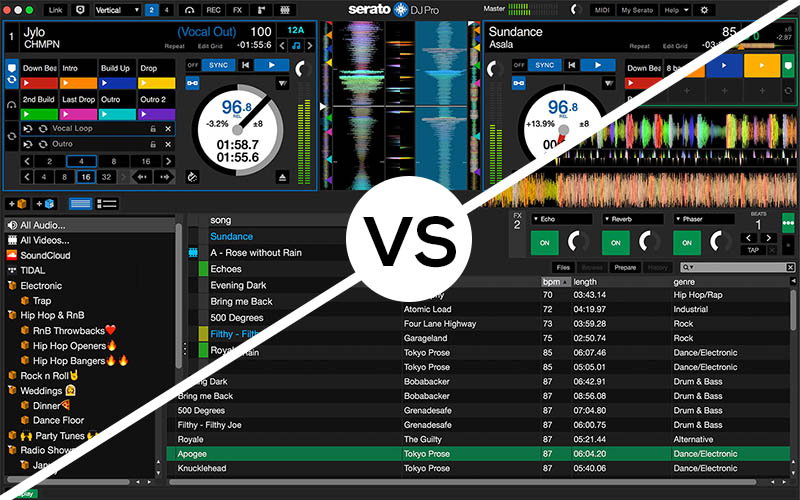Serato DJ Lite vs Pro – What Are the Differences?
Serato DJ Lite and Serato Pro are Serato’s two main software offerings. Simply put, one is free and one costs $99. Serato Lite is naturally limited compared to the paid version but still, it wouldn’t be worth everyone making the upgrade straight away.
Serato DJ Lite can be downloaded onto any laptop, simply plug in any controller with compatible mappings and you’re good to go! Nothing else is needed. There’s no time limits on its use, no deliberate or sneaky restrictions – it’s a transparent solution for beginners and DJs who want to mix flexibly on a budget.
Serato DJ Lite and Serato Pro are Serato’s newest platforms and they run on the same fundamental architecture. Let’s take a look at what they have in common:
The Interface

The interface’s core functions are identical in both Serato DJ Lite and Serato Pro. The UI is ultra hi-res, it looks great on 4K monitors and the latest screens. With crystal clarity and excellent low or bright light performance, both Serato Lite and Serato DJ Pro share the same updated UI.
Also, they are both now 64-bit programs meaning they’re well optimized for the latest hardware. 64-bit essentially means greater stability, even when you’re using libraries with thousands of tunes.
Practice Mode

Practice mode has completely changed Serato for the better. It allows you to practice your mixes and blends without any hardware plugged in. This is excellent for so many reasons, you don’t need controllers to ‘run’ Serato and mix tracks with just your laptop.
Both Serato Lite and Serato DJ Pro have access to this feature, which is excellent.
Cool Extra Features
So actually, most of the improvements from older versions of Serato to Serato DJ Pro and Serato Lite are ‘under the hood’. The core features of Serato have remained largely the same. 64-bit and the hi-res interface are massive improvements, and practice mode is quite revolutionary.
There are lots of smaller features shared between both Serato DJ Pro and Serato DJ Lite:
Control/Command + L
This nifty command allows you to revert to the tune on the deck from within your library. For example, if you’re scrolling deeply through your library and lose your position, you can use this command to jump straight back to the track currently on your deck, which will bring you back to the same playlist, etc.
Adding From iTunes
You can now play songs directly from iTunes without actually adding them to your library. Instead, you can navigate to toggle ‘Show iTunes Library’ and then navigate your iTunes library internally within Serato.
Undo Last Track
This is an excellent addition and is highly useful. By pressing control/command + Z (the typical undo command), you can undo the track you just loaded to a deck. Not only will this remove the track, it will also reload your last track to exactly the same place it was playing. So, if you accidentally load the wrong track, you simply undo it in an instant! Awesome for when you make a mistake.

The Differences
- Expansion Packs

Serato is expandable through several packs which include FX packages, Flip, for cutting and editing tunes, DVS, Pitch N’ Time for pristine pitch and time shifting and Serato Video for video DJing. You cannot access these packages from Serato DJ Lite – you’ll have to upgrade!
- Display Mode
Serato DJ Lite has just one display mode. Serato DJ Pro has 4: vertical waveforms, horizontal waveforms, extended deck view, stack and library.
- Playlists and History
Serato DJ Lite doesn’t allow you to create playlists! You have to just search your library for tracks! Also, Serato DJ Pro allows you to check your mix history so you can go back and create playlists from improvised sets.
- Pads and Cue Points
Serato DJ Pro allows you to control 8 pads instead of just 4. You can use 8 cue points and have 32 sample slots.
Not all DJ controllers have this many pads but still, it’s useful for those who like to operate an army of loops and samples. Also, Serato DJ Pro has a more streamlined pad interface which is accessible on the deck. This is also great for accessing more cue points.
- More FX
Serato DJ Pro has way more FX and they can be chained for awesome combinations. Also, the FX pannel is more heavily tweakable, is easily accessible and is generally streamlined and improved compared to Serato Lite.
- Slip Mode and BeatJump
Slip Mode allows you to manipulate audio in various ways, e.g. by beat jumping, scratching, pitch-shifting, slicing, etc, and the audio will snap back to its original position, allowing you to slip in and slip out of manipulative FX without changing the position of the track.
- Key Analysis
Serato DJ Pro allows you to internally read and write keys to your tracks accurately. This enables you to mix in key, which is absolutely essential if you’re mixing a lot of very melodic material.
- Recording Functionality
This is a key difference between Serato DJ Lite and Serato DJ Pro. Serato DJ Pro allows you to record tunes internally, which is excellent and absolutely necessary for many.
Summary
So, there are clearly key similarities and large differences between the two.
Firstly, though, it’s worth mentioning that both operate on the same architecture. 64-bit and hi-res interfaces are standard. Also, Serato hasn’t lost its classic layout – it’s effectively the same familiar theme as it always has been.
In short, the clinch lies in Serato Lite’s lack of expansion packs, playlists, recording and cue points. Recording is extremely important here, clearly, as it’s not always possible to use a rec-out from a mixer to record your mix if you’re using controllers.
Serato DJ Lite is designed for beginners and those who just want to mix using all the traditional features. For performances, it does the job very well, and if you just want a super-streamlined lightweight solution for mixing then you won’t need much more.
However, if you want to push the boundaries, you will need Serato DJ Pro and the price isn’t exactly super-steep – it’s well worth it!
You may also like: